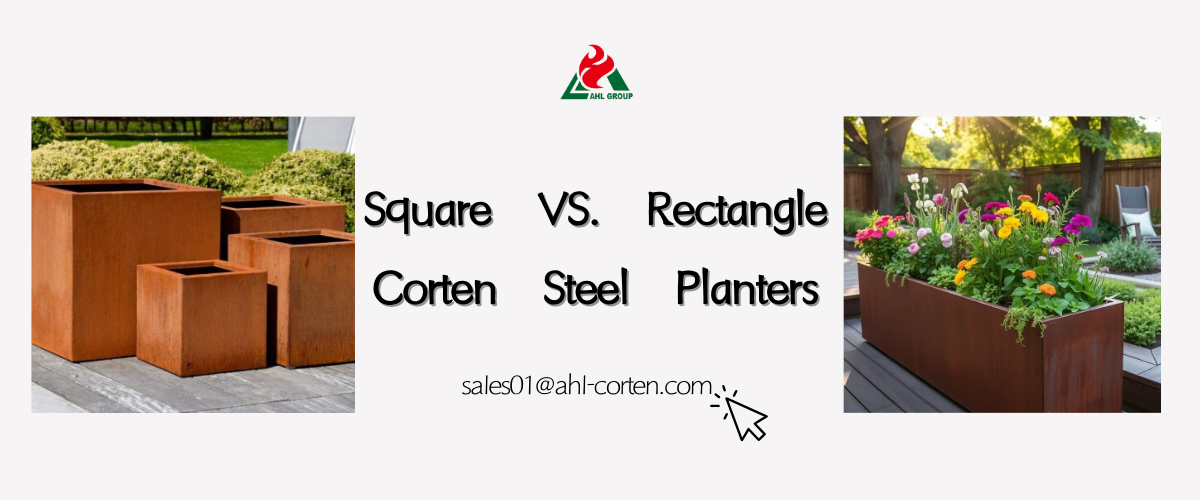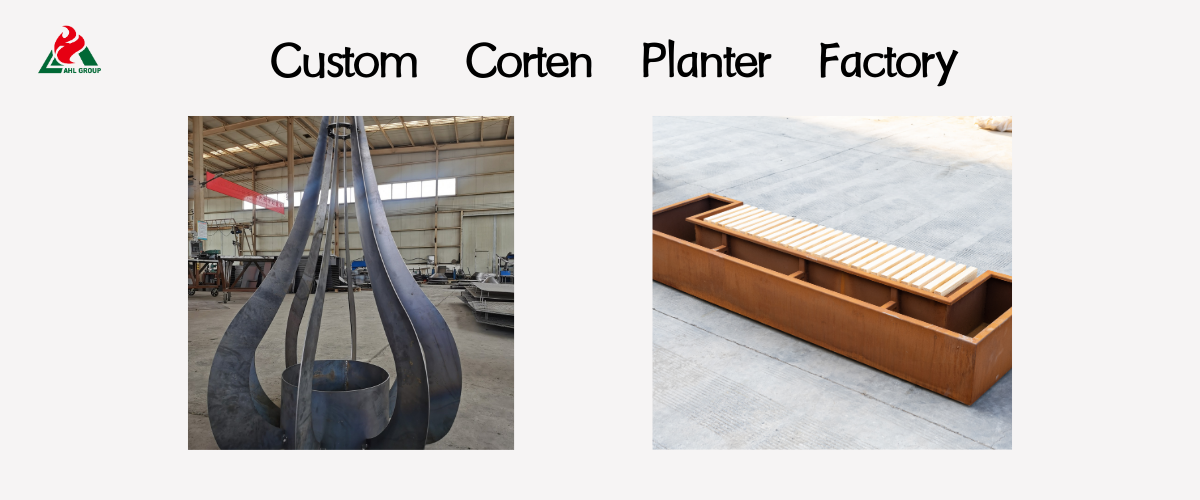Corten steel planters are the preferred choice for modern and rustic landscapes, highly regarded for their unique aesthetic appeal and enduring durability. However, a common misconception exists regarding their long-term maintenance: Should the Corrosion Layer Be Sealed? AHL Group provides a definitive answer: No. The beauty and longevity of AHL Corten steel planters stem precisely from the steel's inherent self-protective properties. This guide will thoroughly debunk misconceptions about weathering steel planter maintenance, explaining why sealing proves counterproductive—not only adding unnecessary upkeep but also compromising the material's inherent properties.


The Corten Steel Planter Maintenance Myth
The design philosophy of Corten steel (also known as weathering steel) is maintenance-free, so sealing it fundamentally contradicts the material's original intent.
Dispelling Maintenance Myths
Many users mistakenly believe that because this material continuously rusts, it requires chemical barriers like carbon steel or cast iron to halt the rusting process. This view is incorrect. Weathering steel is a special alloy (containing copper, chromium, and nickel) specifically designed to form a dense, stable external rust layer (patina). This rust layer itself acts as a protective barrier, shielding the underlying steel from further corrosion.
Embracing the “Zero-Maintenance” Philosophy
The true essence of Corten planter maintenance lies in its “maintenance-free” nature. Once the patina fully matures (typically 12-18 months), your garden planter requires no painting, sealing, or protective coatings. The integrity of AHL Corten outdoor planters is inherently safeguarded by the natural weathering process itself.
Why You Should Never Seal Corten Planters
Sealed Corten steel garden planters interfere with the chemical reactions that make the material durable.
Reason 1: Impeding Natural Protective Mechanisms
The self-preserving function of weathering steel relies on continuous chemical reactions. It requires repeated cycles of wetting and drying to ensure the protective oxide layer remains dense and non-porous. Applying external sealants—especially non-breathable products like varnish or glossy paint—interrupts the critical exchange of oxygen and moisture. Over time, coatings inevitably develop micro-cracks, allowing moisture to infiltrate and become trapped beneath the surface. This persistent dampness induces unstable, deep corrosion beneath the coating, accelerating deterioration rather than preventing it. The resulting rust layer becomes powdery and flaky, failing to form the durable, hard protective crust.
How Rust Forms a Protective Barrier
Weathering steel requires alternating wet and dry cycles to develop a dense, protective rust layer. Applying non-porous sealants—such as most paints or varnishes—blocks oxygen and moisture exchange. This traps moisture beneath the seal, triggering localized, unstable, and destructive corrosion that undermines the steel's inherent weathering capability.
Reason 2: Increased Maintenance Burden
Applying sealant necessitates adherence to future maintenance schedules, which contradicts the very purpose of weathering steel design—to eliminate such upkeep. Standard exterior sealants are not permanent solutions; they degrade rapidly under UV exposure, temperature fluctuations, and abrasion. Within 12 to 24 months, sealants are highly likely to yellow, crack, or peel unevenly. To maintain aesthetics, owners must undergo time-consuming and labor-intensive chemical or mechanical stripping to remove failed coatings, followed by tedious resealing procedures. This repetitive maintenance cycle completely contradicts the zero-maintenance benefit sought by selecting AHL Corten planters.
The Resigning and Maintenance Cycle
Though sealants appear intact initially, UV exposure, water accumulation, and temperature fluctuations will eventually cause peeling, cracking, or bubbling. This necessitates aggressive stripping and recoating—precisely the maintenance cycle self-cleaning weathering steel planter owners sought to avoid. You are creating a recurring maintenance burden that never existed.
Reason 3: Compromising Aesthetic Appeal
The unique charm of weathering steel lies in its organic, matte, and complex texture—rich color variations, and subtle light absorption effects on its surface. Sealants often impart an artificial sheen or plastic-like finish, obscuring this depth. Over time, the sealant itself may yellow or become cloudy, giving the weathering steel an unnatural, dirty appearance or premature aging. Sealing eliminates the rust layer's natural textural variation and subtle transitions from wet (dark) to dry (light) conditions, stripping the planter of its authentic dynamic character—the very quality that makes AHL Corten metal planters a premium design choice.
Loss of Authentic Rustic Character
The natural rust patina of weathering steel is velvety smooth, offering a matte finish with rich texture that subtly shifts with light and humidity. Sealants (especially glossy types) impart an artificial, plastic-like quality to the steel. The true appeal of Corten planter pots lies in their organic, rustic, and authentic appearance—a quality that vanishes entirely when covered by a glossy, static coating.

Proper Care Without Sealing
Corten landscape planters require minimal maintenance. Here is a simple care guide.
Let Nature Take Its Course
The best care for your metal planter is to let it be. Place it in an area exposed to both rain (to keep it moist) and sunlight (to promote drying) to accelerate the formation of an even rust patina. Avoid using covers that trap moisture on the steel.
Simple Cleaning When Needed
If unsightly grime, soil, or bird droppings accumulate on the surface, simply rinse with a hose and clean water. Never use abrasive pads, wire brushes, or harsh chemical cleaners, as these will strip away the protective rust layer.
Drainage Management and Soil Health
Ensure drainage holes at the bottom of Corten steel garden planters remain unobstructed. Proper drainage is crucial to prevent internal rusting caused by water accumulation, which could trigger unstable corrosion. Keep soil levels below the rim to avoid overflow and surface staining.
Troubleshooting Common Issues
Although weathering steel requires low maintenance, minor issues may arise during the initial patination phase.
Addressing Excess Runoff Stains
Within the first 6 to 12 months, loose iron particles may be washed away, potentially staining concrete, pavers, or surrounding surfaces. The optimal solution during this stage is to place a non-porous mat, gravel, or a small drip tray beneath the metal flowerpot. This issue will resolve naturally once the rust layer stabilizes.
Addressing Uneven Rust Development
If certain areas rust more slowly (often due to rain shelter), gently accelerate rusting in these spots by spraying clean water with a spray bottle several times weekly until the color evens out. Ensure the steel dries completely after each application.
Plant Health Management
Trace amounts of iron oxide infiltrating the soil are generally harmless to plants and may even serve as beneficial iron supplements. Weathering steel itself is non-toxic and poses no risk to edible plants or vegetables.

Expert Recommendations
Our guiding principles aim to maximize the inherent properties of the material.
Landscape Architect Recommendations
Landscape architects generally favor the natural, unsealed rust patina. They recommend placing dark gravel or mulch at the bottom of planter pots to conceal runoff marks during the first year, ensuring a clean appearance over time.
Manufacturer Guidelines and Warranty Terms
AHL Group strongly advises against applying chemical sealants or coatings to weathering surfaces. Such coatings interfere with the alloy's natural protective mechanism and may void structural warranties. Always consult our technical specifications before applying any product to steel surfaces.

Frequently Asked Questions About Corten Planter
Q: Can Any Cleaning Agent Be Used on Corten Steel Planters?
Clean only with water and a soft cloth. Avoid using any acidic, abrasive, or industrial cleaners, as these will chemically strip the protective rust layer.
Q: Will Rust Harm Plants?
No. The iron oxide formed on weathering steel is harmless to plants. In fact, iron is an essential micronutrient for plant growth.
Q: How Long Does the Rust Patina Take to Stabilize?
Typically, the rust patina stabilizes and significantly reduces loss within 6 to 12 months. Depending on the frequency of wet-dry cycles in your local climate, a deep, lasting final color will be achieved in approximately 12 to 18 months.
Conclusion: Immerse Yourself in the Natural Beauty of Corten Planters
The greatest advantage of AHL weathering steel planters lies in their self-protective properties. Resist the urge to intervene with sealants or coatings. Embrace the “zero-maintenance” philosophy: properly manage initial rainwater runoff and allow natural evolution. You will witness the planter blossom into its full potential—a durable, beautiful, and authentic landscape element requiring only sunlight and rain to thrive.


